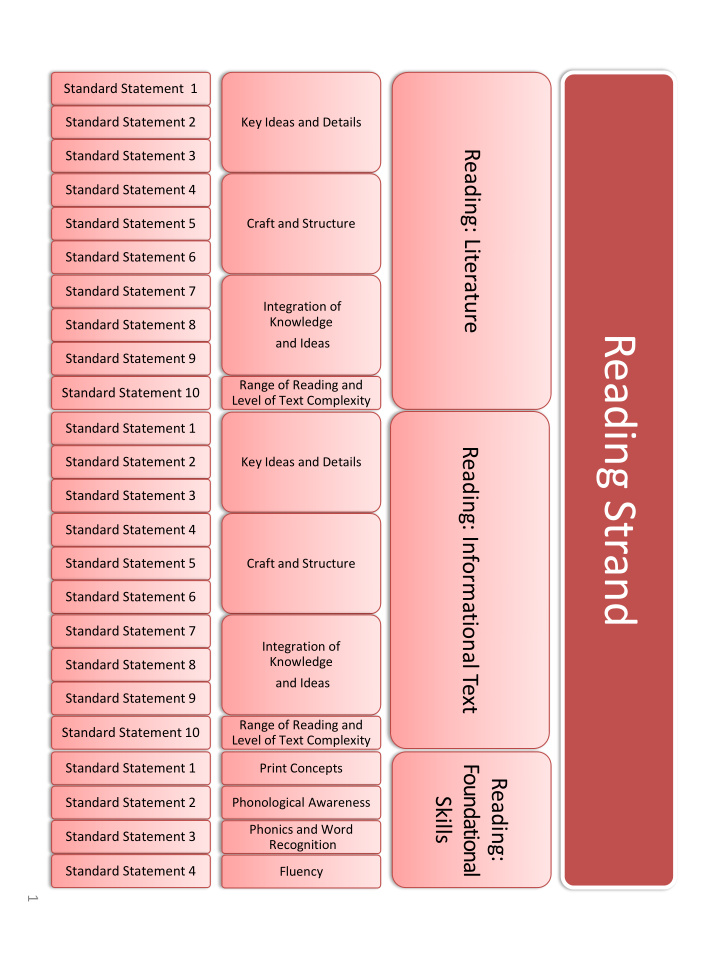



Standard Statement 1 Standard Statement 2 Key Ideas and Details Standard Statement 3 Reading: Literature Standard Statement 4 Standard Statement 5 Craft and Structure Standard Statement 6 Standard Statement 7 Integration of Knowledge Standard Statement 8 Reading Strand and Ideas Standard Statement 9 Range of Reading and Standard Statement 10 Level of Text Complexity Standard Statement 1 Reading: Informational Text Standard Statement 2 Key Ideas and Details Standard Statement 3 Standard Statement 4 Standard Statement 5 Craft and Structure Standard Statement 6 Standard Statement 7 Integration of Knowledge Standard Statement 8 and Ideas Standard Statement 9 Range of Reading and Standard Statement 10 Level of Text Complexity Standard Statement 1 Print Concepts Foundational Reading: Standard Statement 2 Phonological Awareness Skills Phonics and Word Standard Statement 3 Recognition Standard Statement 4 Fluency 1
Close Reading: How? • Don’t summarize what the text is about; allow students the luxury of discovering this for themselves. (Make them think!) • Allow the text to reveal itself to them as readers/detectives. • Lavish time and attention on text that deserves it. • Remember: the teacher is not the expert; the text is. 2
Close Reading: How? 1. Allow them to read text to themselves. 2. Read text aloud to them so they can hear the language as it is meant to be heard. 3.Analyze text by using text-dependent discussion questions. 4. Discuss author’s use of academic vocabulary. 3
introducing background knowledge immersing students in more complex language exposure and usage that makes a difference in their ability to access knowledge engaging students with carefully selected or constructed graphic organizers that make the structure of the text visible modeling how to interpret the meaning of texts that use more complex approaches, like satire or rhetorical argument engaging pairs or teams of students with more challenging texts as “buddies” and giving them opportunities to reflect on those texts through discussions with each other or through “buddy” journals making 20 percent of their class reading “stretch” texts that help them reach beyond their reading level 4
Literary Nonfiction: NAEP’S Definition • May include elements of narration and exposition and is often referred to as mixed text • Includes essays; speeches ; opinion pieces, biographies; journalism; and historical scientific or other documents written for a broad audience • It uses literary techniques usually associated with fiction or poetry and also presents information or factual material 5
Writing Strand Text Types Production and Research and Range and Distribution of Presentation of of Purposes Writing Knowledge Writing Standard Standard Standard Standard Standard Standard Standard Standard Standard Standard Statement Statement Statement Statement Statement Statement Statement Statement Statement Statement 1 2 3 4 5 6 7 8 9 10 6
Writing Shifts • An increase in writing to sources • Emphasis on writing that marshals arguments (using evidence, evidence, evidence) • A significant increase in the amount of research writing (short and frequent projects) 7
What does it look like in grade 3? Text Dependent Non-Text Dependent Ask and answer questions One of the themes in the regarding the plot of Patricia book, Sarah, Plain and Tall , is MacLachlan’s Sarah, Plain and loss. Write about a time when Tall , explicitly referring to the you or someone you know book to form the basis for experienced the loss of a their answers. [RL.3.1] loved one. 8
What does it look like in grade 6? Text Dependent Non-Text Dependent Analyze in detail how the early years Create a story in which the of Harriet Tubman (as related by main character is on the author Ann Petry) contributed to her underground railroad. What later becoming a conductor on the would life be like for this Underground Railroad, attending to character? how the author introduces, illustrates, and elaborates upon the events in Tubman’s life. [RI.6.3] 9
What does it look like in grades 9-10? Text Dependent Non-Text Dependent Analyze in detail the theme of Explore the ways that both relationships between mothers and Chinese and American daughters and how that theme superstitions drive thoughts develops over the course of Amy and choices. Does superstition Tan’s The Joy Luck Club . Students help generations connect, or search the text for specific details that show how the theme emerges does it separate them? and how it is shaped and refined over the course of the novel. [RL.9 – 10.2] 10
Writing to Sources: How? Three practices for strengthening reading through writing: 1. Have students write about the text they read (taking notes, answering questions, learning logs, summaries, or extended response) 2. Teach students the writing skills and processes that go into creating text 3. Increase the amount of time students write. 11
Argument vs. Persuasion in the Common Core Persuasion Argument Appeals to the credibility, Convinces the audience because character, or authority of the of the perceived merit and writer (speaker) reasonableness of the claims and Appeals to the audience’s self - proofs offered rather than interest and sense of identity evoking emotions. Relies on emotional appeals Requires evidence Evokes emotions 12
Marshaling Arguments: Why? When students consider two or more perspectives on a topic or issue, something far beyond surface knowledge is required . They must – Think critically and deeply – Assess the validity of their own thinking – Anticipate counterclaims in opposition to their own assertions 13
Marshaling Arguments: How? • Students must be able to effectively arrange their thoughts to support their reasoning. • Writing must reflect evidence of close analytic reading of complex text. • Writing must show evidence of either advancing an argument or explaining an idea. 14
Research: How? • Students should have multiple opportunities for research (short, as well as sustained projects). • Students should utilize multiple forms of technology to produce, publish, and collaborate with others. 15
Language Strand Knowledge Conventions of of Vocabulary Acquisition and Use Standard English Language Standard Standard Standard Standard Standard Standard Statement Statement Statement Statement Statement Statement 1 2 3 4 5 6 16
Recommend
More recommend